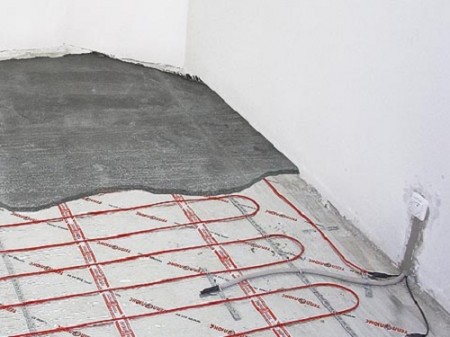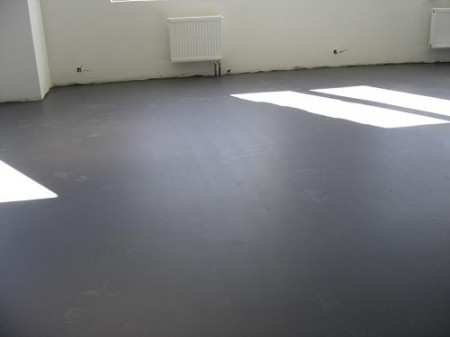The final stage of installation of the electric floor is electrical - laying the screed. The difficulty here is that if the floor heating system can be tested and, accordingly, promptly eliminate all the shortcomings, then pouring the screed will require you to be accurate, attentive and responsible, because to correct mistakes in this case is a troublesome, complex and expensive undertaking, although at present, in modern construction, often began to apply and dry screed. For example, dry screed Knauf It is ideal for flooring of all types and installation of underfloor heating. Let's consider in detail the options for screed using special dry mixes and ordinary cement mortar.
Content
The main problems that can be encountered in the process of laying the screed
The first and main difficulty is the cracking of the finished solution during the drying process.
To avoid cracking, you must:
- Make a solution of the desired consistency - not liquid and not too thick.
- Be sure to install a damper tape around the perimeter.
- If the area is large, make compensation gaps.
- Install a reinforcing mesh over the warm floor.
- Fill the solution step by step.
- Do not overdo it with the plasticizer.
- Observe the required temperature and humidity on the surface of the screed.
- Avoid direct sunlight on the surface of the screed.
- Do not turn on the warm floor until the screed is completely dry.
If your coupler is covered with cracks, do not try to solve the problem yourself - it's best to contact a specialist. To avoid this problem, you just need to follow the recommendations given above.
The device of a screed of a warm floor
Here you can use two options
variant number 1
Make a screed over the warm floor using special dry mixes. They just need to be diluted with water, following the instructions. These are the so-called self-leveling mixtures, which are specially designed for pouring the warm floor. This option is relatively simple. Mixtures are prepared on the basis of gypsum, so they dry relatively quickly - within a week.
It is only necessary to observe the following recommendations:
- Do not break the proportion.
- Do not make the screed too thick.
- Make waterproofing of the surface and adjacent walls.
Screed from ready mixes is most often used for the construction of a warm electric floor, but this option is also suitable for water floors, if the instructions indicate the thickness of the screed, which is suitable for covering the pipes of a warm water floor. Take into account that above the pipe there must be a layer of solution of not less than three centimeters. The installation process is not much different from the bulk floor, you just have to be careful - work in soft shoes, try not to damage the heating elements of the warm floor. On how to dry the screed and test the warm floor, we will discuss below, but for now consider the second version of the screed.
option number 2
With this method, a cement slurry is used. The cement mark should be not less than 300. This option is most often used in the construction of a warm water floor, since the cement slurry is good against moisture, has excellent thermal conductivity, and the thickness of the screed of the warm floor in this case can reach ten centimeters. However, the electric warm floor under the screed of this type is made quite often, since the cement slurry is cheaper than the ready mixes. For the water floor, the screed layer above the pipe must be at least three centimeters, ideally five. Cement mortar is made in the proportion: 1 part of cement grade 300 and above, 4 parts of sand. Add water until a homogeneous mixture of a dough-like consistency is obtained. To check the consistency is quite simple - form a small ball from the solution and put it on the floor. The ball should spread slightly on the floor - do not spread out and crumble!
In order to simplify the work with cement mortar, plasticizers are used. With their help, you can make the solution more "fluid", malleable for alignment. When using additives, you can slightly reduce the thickness of the screed, but the warm floor in this case should not be turned on at full capacity. The plasticizer is added in an amount of 1 to 10 percent of the total volume of the solution. If you add more plasticizer than indicated in the instructions, the solution will crack.
The device of a screed under a warm floor with use of a cement mortar
To begin with, on the entire perimeter of the room you need to lay a damper belt. With its help creates a gap that prevents the appearance of cracks and improves sound insulation. If the total area of the room exceeds 30 square meters, then it must be divided into several squares, and lay the screed in stages in each of them. Separate the area can be strips of polypropylene, or pipe thickness of about five millimeters.
The screed is laid at normal room temperature. For a single section, the operating time with the finished solution should not exceed an hour and a half. At the end of this time, the solution becomes unsuitable for work. Therefore, it is important to calculate in advance how much solution is needed for a certain section of the floor. One section must be filled immediately, it is not allowed to lay the screed in several receptions. You can connect parts, but you need to make a compensation suture. Try not to step on the cables or pipes of the warm floor, and, again, work only in soft shoes!
How to dry the screed of a warm floor
Virtually all cement based solutions are afraid of direct sunlight, and they crack under their influence. Therefore, the first thing to do is to obscure all the windows in the room. After the completion of pouring, it is recommended that the solution be pierced frequently with a thin needle to allow air bubbles to freely surface.
Cement solution dries quite a long time - up to 28 days. To dry the screed evenly, cover it with a plastic wrap and periodically moisten the surface for 7-8 days. After the screed under the warm floor completely dry, turn on the system for about a day to remove the moisture residues from the solution.
As can be seen from the information given in the framework of this article, there is nothing particularly complicated in the screed device for the warm floor, only the accuracy and observance of recommendations are needed. And the screed of a warm floor by own hands on forces everyone can do, not resorting to services of professionals.
























